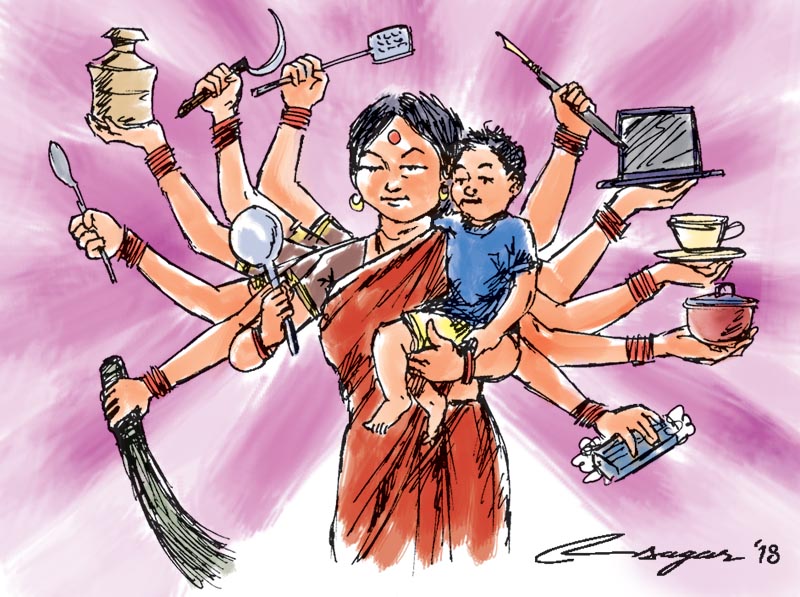Triple burden of women: Conflicting gender norms
Triple role and triple burden of work are the terms that are used to describe the amount of workload among women who are not only involved in economic activities, but are also burdened by the unequal share of unpaid domestic labour
Every day, she wakes up early at five to prepare breakfast for her children so that they don’t miss their school bus. After waking them up, helping them get ready and finally seeing them off, she again returns to the kitchen to prepare coffee and another set of breakfast for her husband and herself. After a quick gulp of coffee and a glance at the morning newspaper she has less than half an hour before she has to leave for work. She hurriedly gets into her work clothes skimming through the notes to the presentation she is supposed to deliver at work today.
At work she stays up-to-date and performs her best while trying very hard to push away the frustration she feels in not being able to protest, even when she knows that she is getting less than what her male colleague gets for the same job. At five in the evening, she returns home, fixes supper and helps her children with school work, after that she prepares dinner, washes the dishes, clears out the garbage, cleans the kitchen and finally at ten she retires to her study to prepare an office report due tomorrow.
This has now become the global reality of every modern-day woman who is economically productive. Triple role/double burden and triple burden of work are the terms that are used to describe the amount of workload among women who are not only involved in economic activities, but are also burdened by the unequal share of unpaid domestic labour. Triple role of a woman refers to her, reproductive role, productive role and the role of community management. The reproductive role of a woman includes care and maintenance (childbearing, rearing and caring) the productive role relates to activities that generate income and the community management role is mostly concerned with functions related to community level activities, domestic work, healthcare etc.
Powerful socio-political, demographic, economical and legal reforms starting from the 1970’s to today’s day and age has brought about dramatic changes in realities in which men and women now live. The concept of a man being the sole bread winner of the family and a woman being the homemaker and caretaker has evolved. A two income family is a common norm in today’s generation. However, with increased opportunities, women have been overburdened yet undervalued for the contributions they make in the personal and professional aspects of their lives. Discrimination and unequal pay have been and still are crucial agendas concerning women empowerment.
In a family where both the parents are employed, women, more than often spend a significant amount of time in household chores, child rearing, caring for the sick member etc. If the average amount of time spent by a married woman doing unpaid work is accounted for, it is evident that a woman spends more than twelve hours a day working. Still, many view it as a “woman’s” work and undervalue it, considering it to be too insignificant for being recognised as “real” work.
The collective situation around the globe is similar. With conditions exacerbated even more so in most nations of Asia. The traditional mindset of the public in countries like India and Nepal is ever resilient, even among the ones with high influencing powers; policy makers and employers.
According to a survey done in Nepal by NDHS, about 68% of the currently married women were employed as of the year 2016. This is a significant figure of achievement for Nepal for women’s empowerment. As more and more women enter the professional world, they are not only exposed to the same work environment as men, but also to unique pressure created by the multiple roles and conflicting gender norms of the society. Stress is thus, inevitable.
Over the time stress due to frustration towards lack of opportunities and oppression has been replaced by stress due to exhaustion, and its detrimental effects on health and wellbeing of women are starting to manifest. For instance, studies on stress among employed women show that stress is a causative factor to mental disorders such as depression which disproportionately affects women. Stress can also give rise to eating disorders that may lead to obesity, which in turn is a risk factor to other diseases such as hypertension, cardiovascular diseases and diabetes.
The plights of women belonging to low-income families in the rural areas are even worse than that of women in urban areas. In most societies, low-income women are highly dependent as they mostly undertake roles that involve care and unpaid work. Along with being engaged in reproductive role, which is, in itself physically and mentally arduous, they are responsible for domestic work, agricultural work and also for gathering of basic necessities like firewood and water.
The societal expectations of women to be able to impeccably juggle their career, children and household must stop. It is not just to expose women to the choice of compromising either their career or their family when men rarely face such debilitating choices. It is high time we adopted methods that challenge the ascribed gender roles so that we can try to improve women’s condition at the household level. It is imperative that we start from our homes and assist them in the roles that have been traditionally set aside and marked as “women only”.
Ban is a student at Institute of Medicine, TU






